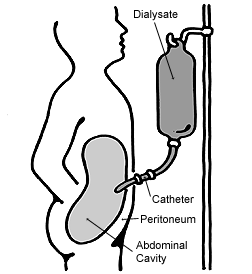
In medicine, dialysis is the process of removing excess water, solutes, and toxins from the blood in people whose kidneys can no longer perform these functions naturally. This is referred to as renal replacement therapy. The first successful dialysis was performed in 1943.

Peritoneal dialysis (PD) is a type of dialysis which uses the peritoneum in a person's abdomen as the membrane through which fluid and dissolved substances are exchanged with the blood. It is used to remove excess fluid, correct electrolyte problems, and remove toxins in those with kidney failure. Peritoneal dialysis has better outcomes than hemodialysis during the first couple of years. Other benefits include greater flexibility and better tolerability in those with significant heart disease.
Delftia acidovorans is a Gram-negative, motile, non-sporulating, rod-shaped bacterium known for its ability to biomineralize gold and bioremediation characteristics. It was first isolated from soil in Delft, Netherlands. The bacterium was originally categorized as Pseudomonas acidovorans and Comamonas acidovorans before being reclassified as Delftia acidovorans.
Campylobacter concisus is a Gram-negative, highly fastidious, mesophilic bacterium that grows under both anaerobic and microaerobic conditions with the presence of hydrogen significantly aiding growth. Motile, with either unipolar or bipolar flagella, the organisms have a characteristic spiral/corkscrew appearance and are oxidase-positive. Although the human oral cavity is the natural colonization site of the bacterium, C. concisus may also colonize the intestinal tract of some individuals. In particular, several studies have reported higher intestinal prevalence of C. concisus in patients with IBD compared to healthy controls, which has led to current speculation of the bacterium's implication in the induction of Crohn's disease.
Helicobacter pullorum is a bacterium in the Helicobacteraceae family, Campylobacterales order. It was isolated from the liver, duodenum, and caecum of broiler and layer chickens, and from humans with gastroenteritis. It is a nongastric urease-negative Helicobacter species colonizing the lower bowel.
Acinetobacter junii is a species of bacteria. Its type strain is ATCC 17908. It can be pathogenic. This bacterium has been linked to nosocomial infections including catheter-related blood stream infections and cellulitis.
Borrelia andersonii is a spirochete bacterium. It can be pathogenic, being involved in cases of Lyme borreliosis.
Inquilinus limosus is a bacterium first isolated from cystic fibrosis patients' lungs, and is rarely observed elsewhere, prompting extensive research into its biology.
Citrobacter farmeri is a Gram-negative species of bacteria.
Citrobacter braakii is a Gram-negative species of bacteria. It has been reported to cause sepsis in an immunocompromised person.
Citrobacter werkmanii is a Gram-negative species of bacteria.
Citrobacter sedlakii is a species of Gram-negative bacteria. It has been described as causing human disease, but is generally found as a non-pathogenic organism in human stools.
Citrobacter gillenii is a species of Gram-negative bacteria.
Citrobacter murliniae is a species of bacteria.
Citrobacter rodentium is a Gram-negative species of bacteria. It infects the intestinal tracts of rodents, and infrequently is an opportunistic pathogen in humans.
Corynebacterium otitidis is a coryneform Gram-positive bacterium first isolated from patients with otitis media.
Neisseria weaveri is a gram-negative bacterium associated with dog bite wounds. It is rod-shaped and non-motile with type strain M-5.
Neosartorya pseudofischeri is a fungus first isolated at an autopsy from a fungal lesion occurring in human neck vertebrae. Its ascospore morphology was identical to that of Aspergillus thermomutatus.
Xenophilus azovorans is a bacterium from the genus Xenophilus which has been isolated from soil in Switzerland.
Janibacter is a genus of Gram positive, nonmotile, non-sporeforming bacteria. The genus name is derived from the two-faced Roman god Janus, referring to the fact that the cells of the original strain could be rod-shaped or coccoid.

